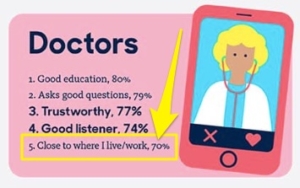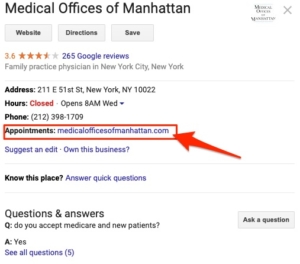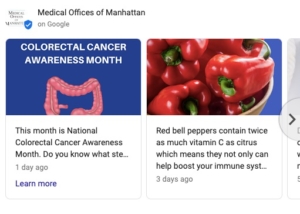Simple SEO Steps for Doctors and Therapists
It wasn’t all that long ago that choosing a new doctor or therapist relied heavily on positive reviews from friends and family. Alternatively, many potential customers simply […]
It wasn’t all that long ago that choosing a new doctor or therapist relied heavily on positive reviews from friends and family. Alternatively, many potential customers simply selected a medical provider through their healthcare plan and hoped it was a good choice. A little further back in time, people walked their fingers through a thing called the Yellow Pages to play “doctor roulette.” Now, thanks to SEO for doctors and therapists–you can attract new patients and continue to provide the best care to new patients while growing your business.
Medical SEO is a critical part of acquiring new patients. The good news is that optimizing your medical practice in cyberspace can be a straightforward process. As simple as 1, 2, 3, in fact.
Why Do Therapists and Doctors Need SEO?
Times have changed and so have the ways that people use to find medical providers. these days, potential patients conduct research about medical professionals from their computers, phones, and tablets.
In a survey of over 1,700 adults in the US, 80% of respondents–that’s four out of five–used the internet for a healthcare-related query in the preceding 12 months. Whether through search engines, directory listings, or insurance provider websites, people know they can find a lot of details to help them decide who to call, and they are making full use of the resource.
Shining a virtual spotlight on your private practices through search engine optimization (SEO) will help potential clients find you and determine if you are a good fit for their needs.
Potential Patient Decision Criteria
In terms of SEO for healthcare providers – whether SEO for doctors or SEO for therapists – there are three key decision criteria that searchers use to find and choose a medical practice. These are important things to keep in mind when optimizing your private practice website to reach the first page of Google. Be sure you have content that reflects each of these search query types.
Decision Criteria 1: Healthcare Plan
The first thing involved in the search for a medical practice is often the healthcare plan that the searcher is covered under. Sites like WebMD advise potential patients that it’s important to check coverage to find out if there are preferred medical service providers or any requirements that will impact their choice of doctor. Many insurance companies have robust “find a doctor” search tools for their customers, so it’s important that your medical practice can be found on the sites for plans that you accept.
Decision Criteria 2: Specialty
Whether a new client is looking for a doctor or therapist through an insurance site or through a search engine, a provider’s specialty will be a factor to narrow the field of choices. Whether you’re a plastic surgeon or offer another niche service, keep this in mind as you work through your healthcare SEO activities.
Decision Criteria 3: Location
A 2017 survey of over 1,000 Americans across numerous demographics reported that 70% of participants thought that a medical practice located close to work or home was an important factor. Though potential clients may be willing to travel outside the immediate area to see a particular specialist – like a plastic surgeon – or a doctor with a great referral from a trusted source, the bottom line is that geographic location plays an important part in deciding who to make that first appointment with.
The Foundation of SEO for Medical Practitioners
There are many facets to medical SEO for online searches. Some are easy to grasp, others not so much. It’s best to start with the basics because without those in place, more complex SEO efforts will fall flat.
Completing these three simple steps will effectively position that online spotlight to help your healthcare practice stand out in search results.
Step 1: Focus on Your Keyword Research
When you are thinking medical SEO – including SEO for therapists – include all the key search variables that are important to prospective patients. Brainstorm a list of keywords and terms that could put your private practice at the top of the search engine results pages (SERPs). Using a search term tool to get quantitative information about the best keywords can be very helpful.
Keep the three user decision criteria in mind when conducting keyword research and come up with variations of words and terms that focus on those. For example, rather than limiting location-related terms to your town, include other relevant location terms like street name, zip code, neighborhood name, shopping center or medical park name, and county. Do the same with healthcare plan provider names (like acronyms as well as the full name) and specialty names.
Don’t Forget to Test
Test things out. Do your own searches using the keywords and phrases you’ve generated and check out the first page of results. Use your findings to come up with a list of words and terms that you can incorporate into your own website content and use in directory listings and other online sites your practice will show up on.
Step 2: Update Your Medical Website
With your new keyword list in hand, review the content on your website and incorporate relevant keywords and phrases naturally into the copy. With page optimization, think creatively and include your words in key spots like page titles and subtitles, image filenames, and alt-tag descriptions of images. Over tine, your content will gain traction and acquire backlinks (which boosts your rankability).
If you can, it’s a good idea to include keywords in your site URL–this might require buying an additional domain and auto-redirecting it to your site. And be sure to review the meta description for every site page to incorporate keywords into the roughly 155 characters that Google will display among organic search results.
Finally, test your page load speed. Google now includes this metric in its algorithm for how websites rank, so find ways to increase page speed if needed.
Start thinking “mobile first” because that’s what Google is thinking. Users are spending more and more time on mobile devices and as a result are doing more online searches from handheld devices. Mobile first means that page load speed and responsive website design, which resizes itself for any device screen size without losing navigational effectiveness, are two requirements that are now part of the ranking algorithm.
Step 3: Set up a Google My Business Profile
You have your list of keywords. Your medical website is updated and pages load fast. Now what? It’s time to focus on that third important factor that goes into a new customer’s decision: the one that 70% of users use to find a doctor or therapist close to home or work. Optimizing your medical website for local search is like turning that virtual spotlight into a laser beam pointing people straight at you.
Google Business Profile: The Prescription for Local SEO Success
Enter Google My Business (GMB). Think of GMB as a search engine within a search engine. This powerful tool focuses specifically on returning relevant results that are local to the user and an easier way to make it to the top of Google results. The goal is to provide rich and robust details like a location map, patient testimonials, and details about the practice in the content delivered to a local search. Medical practices that effectively leverage local citations like GMB have a better chance of growing, attracting qualified leads, and reaching the top of local search results.
Starting Your Google Business SEO Strategy
An effective SEO strategy requires taking full advantage of your Google My Business profile. Fill your private practice listing out completely with quality content and not just your website URL, address, phone, and office hours.
Include great content that will build credibility, establish your online reputation, and give potential patients as much information about you as possible. Ensure that your business page is accurate. Check and double-check that everything is correct and matches what you present on your website. If something changes—like your phone number or office hours—make sure that your GMB listing gets updated.
Google has provided video tutorials to help businesses make the most of GMB. Here is a good place to start.

To make your Google My Business profile stand out as much as possible and maximize the effectiveness of a local SEO strategy to drive website traffic, pay attention to these sections:
The “About” Section
A short summary (no more than two paragraphs) of your practice that incorporates your keywords in a natural way without affecting the user experience.
Appointment Link
This feature allows a current or potential patient to click through to the appointments page or form on your website straight from GMB.
Ratings and Reviews
Online reviews from peers can be a strong influencer for potential patients and Google’s algorithm includes reviews as a ranking factor, so it’s a good strategy to proactively ask patients to post reviews to your GMB listing.
Categories Listing
This section is for general service areas that will help ideal clients decide if you are relevant to their need. The Services section below is for additional detail. Enter descriptions for your service areas that will be recognized by potential patients. Examples include “family practice,” “sports medicine,” and “family counseling.”
Questions and Answers
This section can be very useful in establishing your credentials and philosophy of care and appearing in search results. It allows any user to ask as well as answer questions about your practice. Note “as well as answer,” so monitor this section regularly and respond quickly to any posted questions (using keywords if possible).
Photos and Videos
Images and videos are a great way to enhance your GMB listing and can make a difference to users who find it. Use high-quality content depicting your practice’s office and your staff. A nicely produced video can also be a great benefit and drive quality traffic to your site.
Keep in mind that search engines feature images and videos in addition to page listings–and searchers do look at these when choosing a medical practice. These photos tell the searcher what to expect when they arrive and offer a peak into your practice’s style and sanitation levels.
Services
This section allows you to expand on the services you listed in the Categories section and is an opportunity to set your practice apart in your areas of specialty. For a practice offering family medicine, for example, the Services section might offer details about annual checkups, high school sports exams, women’s health services, and geriatric care. A local therapist specializing in family counseling might offer Services details for relationship counseling, life transitions counseling, and premarital counseling.
Posts
Posts are unique content that helps you stand out and give users a sense of you and your practice at a glance.
Each piece of content is live online for only seven days, so you can use this section to promote specials, offer reminders, post seasonal messages, or provide excerpts from your site blog to catch users’ attention and interest. Examples include an announcement that it’s National Blood Donor month in January, a reminder to “take along the sunscreen” just before Memorial Day weekend, and a “we are ready for your school sports physical exam” in the late summer.
Insights
This is the place to see how your GMB listing is performing. This includes data like the number of visits the listing receives, what keywords are attracting people to your listing, and what images are viewed most often.
Does this look like a lot to do? It can be, but it is well worth the effort to fully complete your GMB listing. Approach it as a project that spans a period of time–a month, a quarter–and make regular progress.
Once your listing is complete, maintain it. Respond quickly to submitted questions, ask patients to post reviews about your practice, add posts on a regular basis (remember they only “live” online for seven days), and add photos and videos. And, of course, integrate your keywords in all the content you have on your listing.
These local SEO activities will give you a good ROI on the time you and your staff invest in your GMB listing.
Stepping up to the Next Level of Medical SEO
Once the simple 1-2-3 SEO process is done, there’s more to think about in order to get to the top of Google. Here are some of the factors to consider that will help you continue to improve your search engine rank. They also allow you to use your medical SEO strategies for maximum advantage–all in the service of bringing new patients to your practice.
- Apply your GMB know-how to other online directories relating to your practice (e.g., through an insurance provider, hospital affiliation, industry association that caters to consumers).
- Start or resuscitate your blog. Blogs are no longer optional, especially for medical practitioners. Google includes quality of content in its ranking algorithm and gauges page rank according to expertise, authority, and trustworthiness. Feed your blog frequently with medical content that showcases the expertise and knowledge of your practice. And use those all-important keywords for better page optimization. A better blog will result in more backlinks–and this will not only increase direct traffic to your site, but it will also increase your domain authority.
-
Consider building backlinks through guest posts. This best practice for link-building will not only further establish you as a leader in your field, but it’s also an effective way to increaser your practice website‘s performance in the SERPs–and it draws in pre-qualified web traffic.
- Think voice search. Personal assistants like Siri and Google Play are here to stay, and people are moving to hands-free searches by vocalizing their searches. This will impact those ever-changing ranking algorithms, so keep an eye on how voice search may change that organic results work for your practice.
- Consider using Google Ads (AKA Adwords or Google Adowrds) to take a shortcut as you wait for your site to climb the SERPs. Google Ads will display your site at the top, side or bottom of the first SERP page for designated search queries.
Keep the SEO Going
SEO for doctors and therapists is not a one-and-done thing. The internet is dynamic, and consumer behavior and search engine algorithms continuously change. An SEO strategy must be ongoing, with due diligence around the market in which you practice and with continual monitoring of how effective your online presence supports your internet marketing success in the long run.
Commit time in your schedule to:
- Keep your web presence updated and fresh with the quality content that influences your potential patients. This includes regular, informative, and useful blog posts which can double as email marketing.
- Stay up to date with web page ranking practices and how those affect SEO for medical practitioners and SEO for therapists.
- Do your own market research. Act like an ideal client and conduct a Google search on desktop and mobile devices – from the keyboard and by voice – to see what comes up in Google search results (and get your staff and family to do the same).
- Measure qualitative and quantitative results and use these to guide future optimization strategies.
Getting to the Top of Google Takes An On-Going Effort
Start with the simple steps outlined here to get your search engine optimization foundation well established for the best local SEO. Follow through with continuous monitoring and adjustment to improve your visibility and reach the top of Google search pages. Keep your eye on trends that could affect your SEO strategy and incorporate them as needed. This is the road map to the best ways online marketing can grow your practice.


















































































